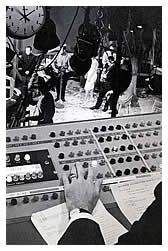
A view of Studio One from the upstairs control booth.


A view of Studio One from the upstairs control booth.
On a recent day here at the BT Memories bat cave, the email bell dinged and, lo, an epistle from Bob Storck arrived. After some encouragement, he sent several others, each containing colorful stories and memories of WBTV in the '60s. We've put them all together for your enjoyment on a page that we call ... |
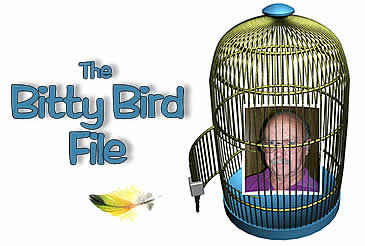 |
My brother, Dick Storck, was a summer intern at WBTV on the "Floor Crew" while he was going to UNC's Radio, TV & Motion Picture School back in the early 60's. (He is still in broadcasting himself as program director for WCPE-FM near Raleigh, NC.)
In a recent email to me, he passed along the link to this website. What a treasure trove of memories exist here. Perhaps it is not a plethora of memories but it certainly qualifies as a "pleth."
It seems that true to the migratory nature of the bird for whom I am named, I came full circle and returned to the proverbial roost. My very first job at the callow young age of 16 and while still in high school in the 60s, was at WBTV as a projectionist in the film department. Back then I operated the film chains which showed the slides, commercials, movies and syndicated shows on film. I worked in many other positions during my sojourn there. Floor crew, News Department cinematographer, and photo lab technician were among them.
 |
| Bob uncaged |
Over many years, I worked at other occupations in the technical field at 3M, Xerox, and IBM. Now I am back in show biz, working at a CBS affiliate in Greenville, NC.
At one point both my brother and I worked at good ole "BTV" which caused some confusion. When a director called for "Storck", he would get a stereo response from us.... "Which one?" The rejoiner would either be "the Big one" (my brother, the elder one) or "the Little one" which was me.
Norm Prevatte, one of the directors and a bit of a wit ended up changing this to "Big Bird" and "Bitty Bird". For some reason "Bitty Bird" stuck and that was my nickname for many years there.
(A friendly wave and “high sign” to the folks out there who might remember the Bitty Bird.)
I would like to offer a few anecdotes about my years there. I have many fond memories. This perhaps explains why I eventually returned to broadcasting... Like bookends, broadcasting was the first job and now appears to be the last one as well.
Having discovered a glaring need for improved transportation in Eastern NC, I pitched my tent and am presently starting to dig the "Chocowinity/Pactolus Tunnel" under the Tar River near Greenville, NC. I had intended finding a tunnel and having it moved like the Glick family did, but the cost of the relocation these days would surpass that of moving the Hatteras lighthouse. A shovel at the local Ace Hardware is less expensive.
OK, now for the truth.
I am married... still... have two children... A daughter (15) and a son (8)... I started my family late in life and these kids are what still help keep the mind alive.
I live in Greenville, NC which has many similarities to Charlotte in the mid 50s. I work at WNCT TV 9, A CBS affiliate here. This is for the steady cash flow.
For pleasure and sometimes supplemental income, I am the owner/operator/editor and janitor of Storck's Roost Video Productions. (A little one man operation making commercials, video presentations, and wedding videos.)
I think I arrived in the video production business, though. Three months ago, I got a call from someone wanting to hire me to do a porn video of him and his wife doing "The Deed." I told him that while I appreciated his calling Storck's Roost, I didn't feel that in such a setting that I could maintain enough objectivity to do a good job of videotaping them.
|
In television of the 60s, there were only a few ways of getting video out to the viewer…. Do it live with cameras, do it in a recorded fashion by film and slide projector linked directly to a camera or by a device called the Chromascan opaque projector.
WBTV had two film chains; one was set up to do color, the other black and white. Each film chain consisted of two RCA TP-6 16 millimeter motion picture projectors and one RCA TP-7 slide projector. Each of these were mounted around a mirror box with solenoid activated mirrors. These mirrors would flip up at the press of a button to bounce the light from the projector into the lens of a camera.
Film was rolled on a two second delay to allow the projector to get up to speed before switching it on and sending the audio and video out to master control. Slides were switched according to a script that the projectionist and the duty announcer both had copies of. The script had the narration and markings for when each particular slide needed to be switched. If the scripts did not match, a slide commercial could get quite interesting quite fast.
When I first was hired, there was also a big piece of equipment in the corner of the projection room called the Chromascan. This consisted of a pair of big ominous looking dark gray boxes with radiation warning stickers on them. They were a pair of opaque projectors. The principle was to slide a card of artwork through a slot in the side of one of the boxes and this monster would somehow convert the card's artwork into color video. These were phased out in the '60s so I rarely had much need to use them.
There were some musicians who played in the TV studio but never got on the air.
On the floor crew, teamwork was paramount to putting on a good show. Working together like this would often bring about friendships that would linger past the time when the ON AIR lights were extinguished.
A crewmember named Ken Beaver (who later became a producer/director) and I discovered our mutual love of music. He played a 12 string acoustic guitar and I played around with a banjo. One night after the 11pm news, we got together in studio B with our respective instruments and decided to see what songs we both knew. Several hours and many sore fingers later, we found that we had a repertoire of music which included Kingston Trio, Simon & Garfunkle, and Peter, Paul, & Mary. We continued to do this after hours for many months on those days when our work schedules coincided. Ken went on to directing, I moved over to the newsroom as a cinematographer and so our late night jam sessions dwindled away.
I would LIKE to say that we chose Studio B for its acoustic sound properties which would bring out the best in our respective voices and instruments but, if truth be told, it was more like the sound proofing in the studio kept us from inflicting our brand of musical mayhem upon any other ears but our own. Still, we had fun and found this to be a good way to unwind after the show.
![]()
While not on a par with the great blackout in New York, I do recall one power failure we had at WBTV.
One of the nicest folks at the station was Jay Torrence who was Virgil Torrence’s brother. (Did you ever notice the high number of brothers who worked at the station? Babb, Torrence, Townsend, McDaniel and a couple of others, I think.) but I digress.
Jay was the building's maintenance chief and if anyone needed anything fixed, Jay could usually do it. There was a time, though, that Jay was worried about a tree behind the station. It was getting old and was too close to the incoming power lines. He was concerned that in a storm this tree might fall and knock out power to the station. So, one bright, sunny day he (and I think a couple of others) started to cut the tree down.
It was at that strategic moment when the tree was ready to topple that a little zephyr of a breeze blew in the wrong direction, thus helping to fulfill Jay's prophecy that this tree could cause a black-out at the station.
I still remember Jay sitting dejectedly on the hill above the fallen tree and downed power lines.
Betty Feezor was the ultimate professional. If something went wrong, she would not acknowledge it on the air but would continue without missing a beat. On more than one occasion I, as floor manager of a particular show, would crawl along behind the kitchen counter island where Betty was preparing a recipe. She would be mixing the recipe with one hand and holding the other hand down and behind her while I applied first aid to the cut or burn that she inflicted on herself. For awhile, Betty would prep the recipe with one hand and a little later the other hand would appear in the camera's picture with a bandaid on the injured digit. The audience would never know since Betty continued without so much as a pause.
Crews were never in short supply to work the Feezor show.
When Betty cooked a recipe on the air, she would often make two of them. One was done before the show and the other was done while preparing the raw ingredients on the air. This way, if the recipe took a while to cook, she would have the finished one to show our viewers. As was stated by others on this website, one of the benefits of being a crewmember working her show is that after the show, Betty would feed her extended family of floor crew guys. We got to sample her finished recipe and Betty would take the one she made on the air home to feed her family.
I also benefited another way as well. The recipe ingredients were “supered” over Betty’s actions in preparation. In my days on the floor crew, the source for the “super” was a small sheet of plastic with a black carbon coating on one side. The recipe would be typed onto this thin plastic sheet. Carbon would be transferred off leaving a clear type with black background on the plastic. We would then tape the sheet onto a translucent milk-glass light box and a camera would shoot a closeup of it.
If I found that a particular recipe was extra delectable, I would very carefully remove the plastic sheet from the light box, take it home with me and tape it into a loose leaf notebook, so that I could try to re-create this recipe later. I got many excellent recipes this way and used them for many years until the carbon rubbed off rendering the ingredient list illegible.
While not on a par with the great blackout in New York, I do recall one power failure we had at WBTV.
One of the nicest folks at the station was Jay Torrence who was Virgil Torrence’s brother. (Did you ever notice the high number of brothers who worked at the station? Babb, Torrence, Townsend, McDaniel and a couple of others, I think.) but I digress.
Jay was the building's maintenance chief and if anyone needed anything fixed, Jay could usually do it. There was a time, though, that Jay was worried about a tree behind the station. It was getting old and was too close to the incoming power lines. He was concerned that in a storm this tree might fall and knock out power to the station. So, one bright, sunny day he (and I think a couple of others) started to cut the tree down.
It was at that strategic moment when the tree was ready to topple that a little zephyr of a breeze blew in the wrong direction, thus helping to fulfill Jay's prophecy that this tree could cause a black-out at the station.
I still remember Jay sitting dejectedly on the hill above the fallen tree and downed power lines.
Betty Feezor was the ultimate professional. If something went wrong, she would not acknowledge it on the air but would continue without missing a beat. On more than one occasion I, as floor manager of a particular show, would crawl along behind the kitchen counter island where Betty was preparing a recipe. She would be mixing the recipe with one hand and holding the other hand down and behind her while I applied first aid to the cut or burn that she inflicted on herself. For awhile, Betty would prep the recipe with one hand and a little later the other hand would appear in the camera's picture with a bandaid on the injured digit. The audience would never know since Betty continued without so much as a pause.
Crews were never in short supply to work the Feezor show.
When Betty cooked a recipe on the air, she would often make two of them. One was done before the show and the other was done while preparing the raw ingredients on the air. This way, if the recipe took a while to cook, she would have the finished one to show our viewers. As was stated by others on this website, one of the benefits of being a crewmember working her show is that after the show, Betty would feed her extended family of floor crew guys. We got to sample her finished recipe and Betty would take the one she made on the air home to feed her family.
I also benefited another way as well. The recipe ingredients were “supered” over Betty’s actions in preparation. In my days on the floor crew, the source for the “super” was a small sheet of plastic with a black carbon coating on one side. The recipe would be typed onto this thin plastic sheet. Carbon would be transferred off leaving a clear type with black background on the plastic. We would then tape the sheet onto a translucent milk-glass light box and a camera would shoot a closeup of it.
If I found that a particular recipe was extra delectable, I would very carefully remove the plastic sheet from the light box, take it home with me and tape it into a loose leaf notebook, so that I could try to re-create this recipe later. I got many excellent recipes this way and used them for many years until the carbon rubbed off rendering the ingredient list illegible.
Working at WBTV as a teenager and later as a young man gave me many opportunities to improve myself. The experiences I relate next do NOT fall in this category but are still fun to remember.
Being a somewhat naïve, willing to please young man who didn't mind the humiliation, I was sometimes called upon to don a costume and help out as an "extra" whenever one was needed. There I was able to exercise my skills as a television thesbian (sic). These included being the dead body on Phillip Morris' "Horror Theatre," The Doodle Bug Game Warden on "The Tommy Faile" show, The funny bunny on "Big Bill's Clubhouse" and my most famous appearance as the gorilla that Irving Glick battled in the center ring of Ringling Brothers, Barnum & Bailey Circus. Bill Curry was the referee and sportscaster at the latter event where he was quite adept at describing the carnage that ensued.... outside the arena as Glick decided that the children should not be subjected to such violence and wisely lured the gorilla out of the arena (by running).
Alas, there were no Hollywood producers in the audience that night and so I never quite made it into the movies. Also, no Hank Warren photos of these episodes have come to light, though I do remember Hank taking some. My son and daughter would have a field day with these photos if they saw them. Right now they don’t believe me and I wish to keep it that way.
Here are a couple of photos I dug up from my days at BTV.
One was a set-up in the film chain room when I was a projectionist. Bill Curry also did a stint recording intros and wrap-ups to the movies that we showed after the eleven o’clock news. This was in conjunction with the Friday night “Horror Theatre” movies that “Dr. Evil” (Phil Morris) introduced. In this particular intro, Bill was taking the viewers on a tour through the station showing master control and where the movie actually originated. I was projectionist on duty and started the projector as the intro to the actual movie. The wrapup showed me “asleep at the switch” and supposedly covered with the film that just aired.
The oher was just a re-do of the same theme, this time when I was a little older and in the news department: Breaking news… broken camera…
 |
 |
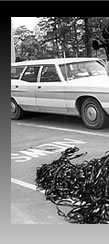 |
 |
||||
Broadcasting has sometimes been described as hours of boredom lightly interspersed with moments of panic and intense concentration on the task at hand. One thing that is to be avoided at all times is something called "Dead Air." This is where there is nothing going out to the viewer/listener and is often caused by a human error or equipment failure. Dead air is sure to get the viewers’ attention and prompt telephone calls to the station.
On fall weekends, WBTV would broadcast live football games. As a projectionist, there wasn't a whole lot to do at these times. FCC regulations required that we have a station break at least once an hour near the top of the hour. The break would allow us to run a few commercial films and end with the WBTV ID slide and the duty announcer intoning, “WBTV, Channel 3, Charlotte”… before returning to the football action.
With football, this break was called a "Floating Break" and could occur within a 20 minute window between 10 minutes before to 10 minutes after the hour. Waiting for the break was boring but one shouldn't go too far away since CBS could surprise you with an off time and they didn't give much warning when they were going to give us our break. Most often it was simply a pause in the sports narration and the sportscaster would simply say "We pause now for station identification. This is the CBS Television Network." My duty then was to start my projector on "CBS" and put it on the video line to master control at the end of the word "Network." This was the two seconds necessary to get the projector up to speed.
As is often the case when there is too much idle time, someone will come up with something to break the monotony.
In this particular case that someone was a weekend duty announcer named Reid Swann. His accomplice was Jud Gregory who was the engineer on duty in master control that day.
Reid, using the lure of "I'll buy if you fly," asked me to get a couple of soft drinks from the machines in the scene shop. I took the bait and went for drinks. As I returned to master control with drinks in hand, Reid engaged me in conversation.
Suddenly, there was a brief pause in the sportscaster’s narration and I heard over the speakers "We Pause now for station identification.............." PANIC ENSUED.....I WAS AWAY FROM MY POST!!!! In fact, I was not even in the projection room which was about 20 yards away.
Everyone hollered "RUN!"... I took off around the equipment racks not unlike a quarterback fleeing a cadre of linemen from the opposing team. I could almost feel the dreaded "DEAD AIR" looming over me. In my single minded attempt to get to the projection room, I nearly knocked over an engineer who was coming down the hall in the opposite direction. Yelling, “Sorry!” over my shoulder, I reached the projection room and made a lunge for the projector’s control buttons. I started my projector and put it on the air to Jud in Master Control.
Only then did I look up at the "air monitor". Instead of the commercial that was running through the projector, there was the football game still in progress. My helmeted counterpart on the “Tube” had just gotten the ball and was emulating my broken field run.
From Master Control, came gales of laughter.
They got me.......... good.
Jud Gregory had recorded the audio of the System Cue from a previous break and in one of the best audio cross-fades I ever experienced, he seamlessly put this fake system cue onto the Master control monitor speakers while leaving the normal audio still going out to the transmitter. The trip to get sodas was to get me out of position and to allow Jud to prepare the prank audio tape.
Each portion of the broadcast day had its own unique aura about it.
One special time for me was the early morning shift with its sign-on and morning news, weather and farm reports. Yes, friends and neighbors, WBTV had information for the dwindling population of farmers within the burgeoning metropolis that was Charlotte. Gil Stamper, a highly underrated and understated announcer, was the guy with all the wheat and hog prices each morning. He did the "Farmer's Almanac" just after the morning station sign-on and was to the TV- watching-farmers what Grady Cole was to the radio-listening agriculturalists. Gil claimed that nothing anyone could do in the studio could break him up.
He was nearly right. Jim Patterson got him... and the rest of the crew one morning.
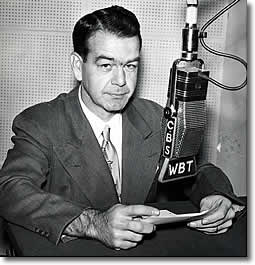 |
| Gil Stamper |
At that time we did a morning report show. Gil would do the farm report and weather while Jim Patterson would do the news and any special guest interviews. Since I was the newer member on the floor crew, one of my tasks to prepare for the day was to brew a pot of coffee for everyone... talent, crew, and guests to share. Since I passed by a donut shop on the way into work, I would often pick up a box of assorted donuts to go with the coffee. I generally didn't specify the type of donut but let the shop clerk pick out a dozen for me. This morning, the clerk dropped a couple of chocolate crullers into the box along with the others.
Jim, while browsing through the assortment just minutes before air time, spied one of the crullers which had been mis-shapen from its original form and was a nondescript brown lump. Very gingerly, he picked it up... looked it over carefully and with great drama.... set it gently on the studio floor. He looked it over and when he was sure that everyone's attention was on what he was doing, Jim said, "Sure glad we didn't step in it."
Everyone broke up with this statement... especially Gil who was still chuckling as I counted them down and cued them to camera two for the start of the show. This lump of cruller stayed on the floor for the whole show. Every time Gil saw it, he would start to break up again and had a very tough time maintaining his composure during the show. The audience at home never knew the reason for Gil's mirth but we sure did.
Being a double amputee didn’t slow “Mr. Van” down much. He was an accomplished bowler in Jefferson Standard Broadcasting’s league and while I was able to get up almost to a 140 average, he was consistently a better bowler than many of us and if I recall had a 150 to 160 average. His style was somewhat unorthodox. With ball in right hand and cane in the left, he would walk up to the foul line, lean over and, pendulum-like, would swing the ball. On the second forward arc of the ball he would release. While my ball would go kaBang when it hit the lane, his was just a whisper and while it never had the speed of other folks' balls, it generally went where he wanted it to go. At times when I felt frustrated at my inability to bowl well, I would simply look over at “Twinkle Toes” and say to myself, “If he can do it, so can I.” Without his knowing it he was both a humbling and inspirational force for me.
One thing that I learned from being around the television engineers in Master Control was how to keep your composure when things were going wrong.
One day the sync generator died.
(For the benefit of most everyone else, the sync generator created a signal which was sent out along with the picture and sound. The sync is what would tell your home television when the next frame of picture was going to start. Without this sync pulse, your TV would show only a very hashed up picture at best.)
So, we had sound but no picture. All the engineers on duty were frantically going through the many racks of tube-type equipment with meters and jumper wires to try to figure out where the problem was.
Did I say all? Well, let me rephrase. ALMOST all the engineers. There was an exception. Howard Caldwell was seated in front of the audio board and video switcher in the center of the Master Control area. He had his feet propped up on the counter with his pipe in his mouth and was looking at the beehive of activity going on around him. Shortly, he heaved a sigh, set his pipe down, got up, walked over to a rack of electronic equipment, eyed it up and down, then hauled off and KICKED it HARD! The sound of that kick reverberated through the room and caused all human activity to cease momentarily. The vibration of the kick evidently caused a shorted tube or intermittent connection to go away and the sync generator came back online.
Following this percussive troubleshooting procedure, Howard, without a word returned to his chair, picked up his pipe and propped his feet back up on the counter top.
When I expressed my amazement at his methodology, he winked at me and said. “Its all in knowing where the 'X' mark is.”
In the early 60s, Video Tape was a brand new technology and WBTV was one of the pioneers in this technology. RCA and WBTV partnered to install the first production model of the TRT-1. This played two-inch-wide video tape on huge, heavy reels. Soon after the TRT-1 came the TRT-1A which was capable of recording and playing back color video.
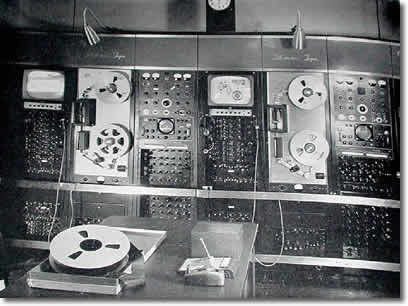 |
| A wall of two RCA TRT-1s |
The technology had not yet advanced to enable electronically editing the tape, though. One either recorded multiple takes until a usable one was achieved or the tape had to be spliced. Editing was a nightmare. It was done almost like cutting film at the frame line. I recall, Keller Bush and Dallas Townsend doing this. They first had to find where the edit needed to be made on the tape and mark the back of the tape with a grease pencil. Then they carefully unloaded the tape from the TRT-1(a) and placed it on a special editing block which had a microscope attached. A developing solution composed of alcohol and extremely fine powdered iron shavings was applied to the recording surface of the tape. This would develop the magnetic fields created by the tape recorder. The microscope allowed the engineer/editor to see the sync pulse/contol track and video recorded on the tape. The next challenge was to cut the tape just at the sync pulse and splice the next piece of tape with similar cut point (at the sync pulse) together with the first. The two would then be joined with a thin specially-made splicing tape. If the cut and splice were not perfect the picture would tear up and roll until the TRT-1 could figure out where the sync pulse was again. Dallas Townsend and Ken Helms got pretty good at editing this way but everyone was greatly relieved when a few years later, electronic editing was developed.
The TRT-1s were tube type and HUGE. Two of them barely fit into the room where they were installed and the heat from the electron tubes required that the room have its own dedicated air conditioning lest the electronics (and the operators) melt from the heat. When the TRT-1s were phased out and replaced with the RCA TR-22s which were transistorized, the tape room acquired much more elbow room. Before the air conditioning was subsequently adjusted, one could almost hang a side of beef in that room after the new tape recorders were installed.